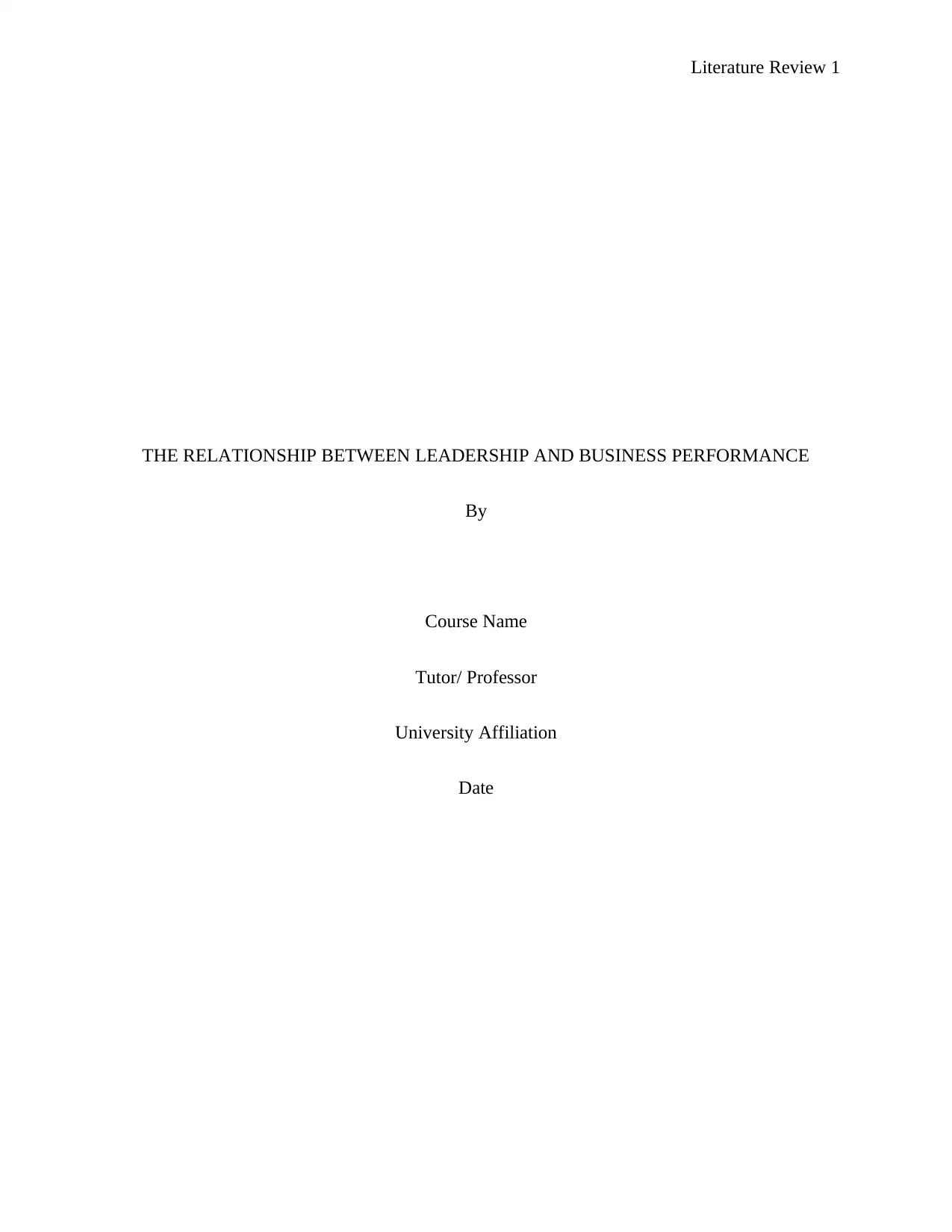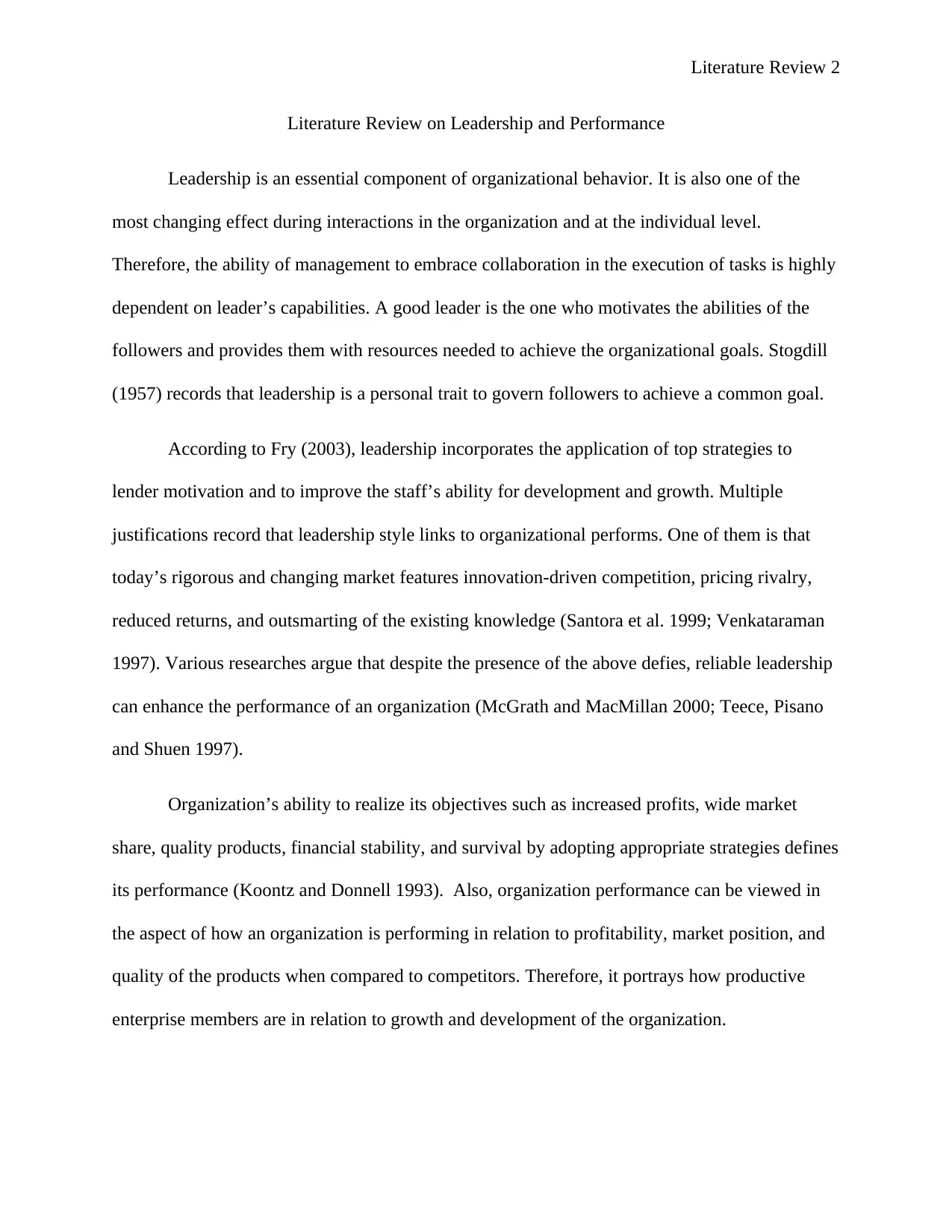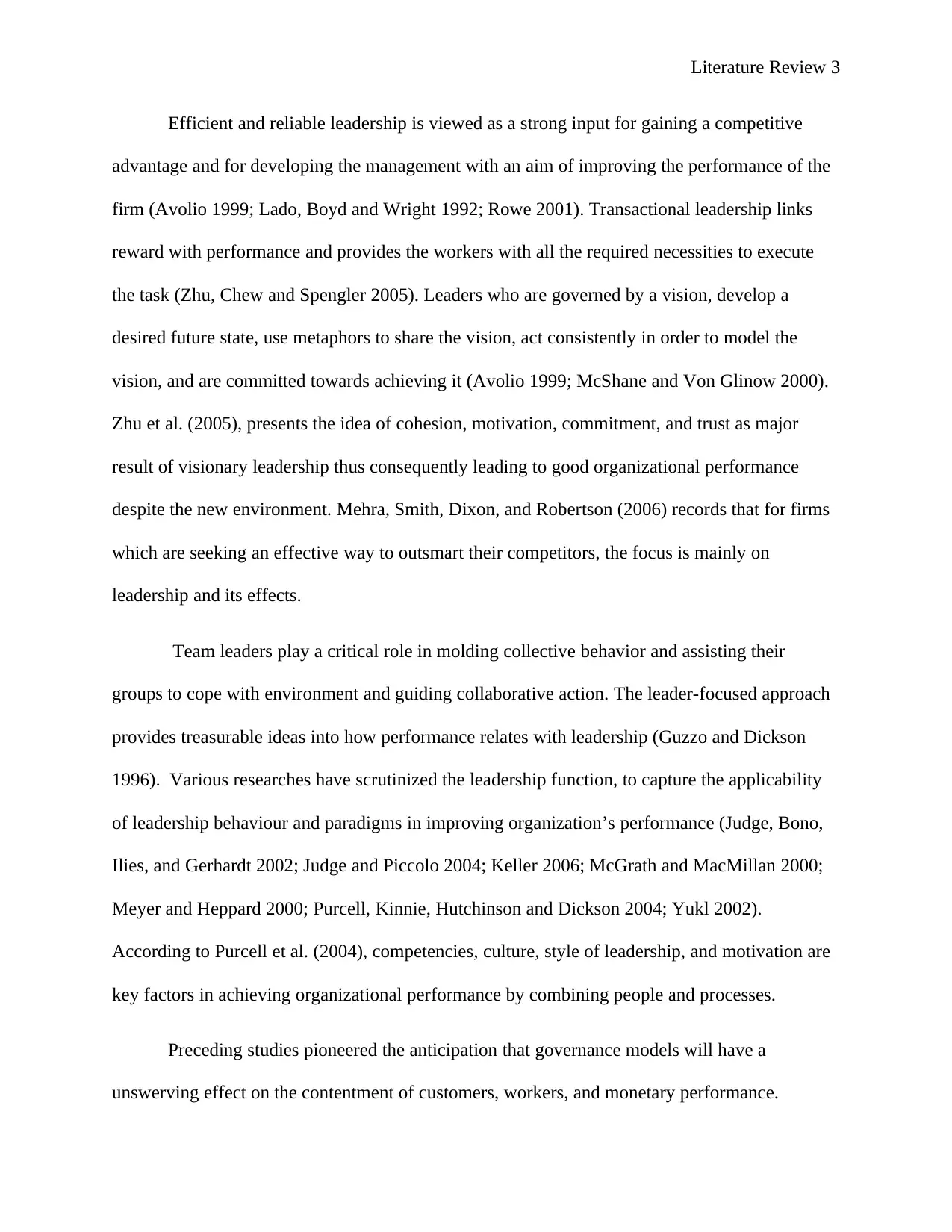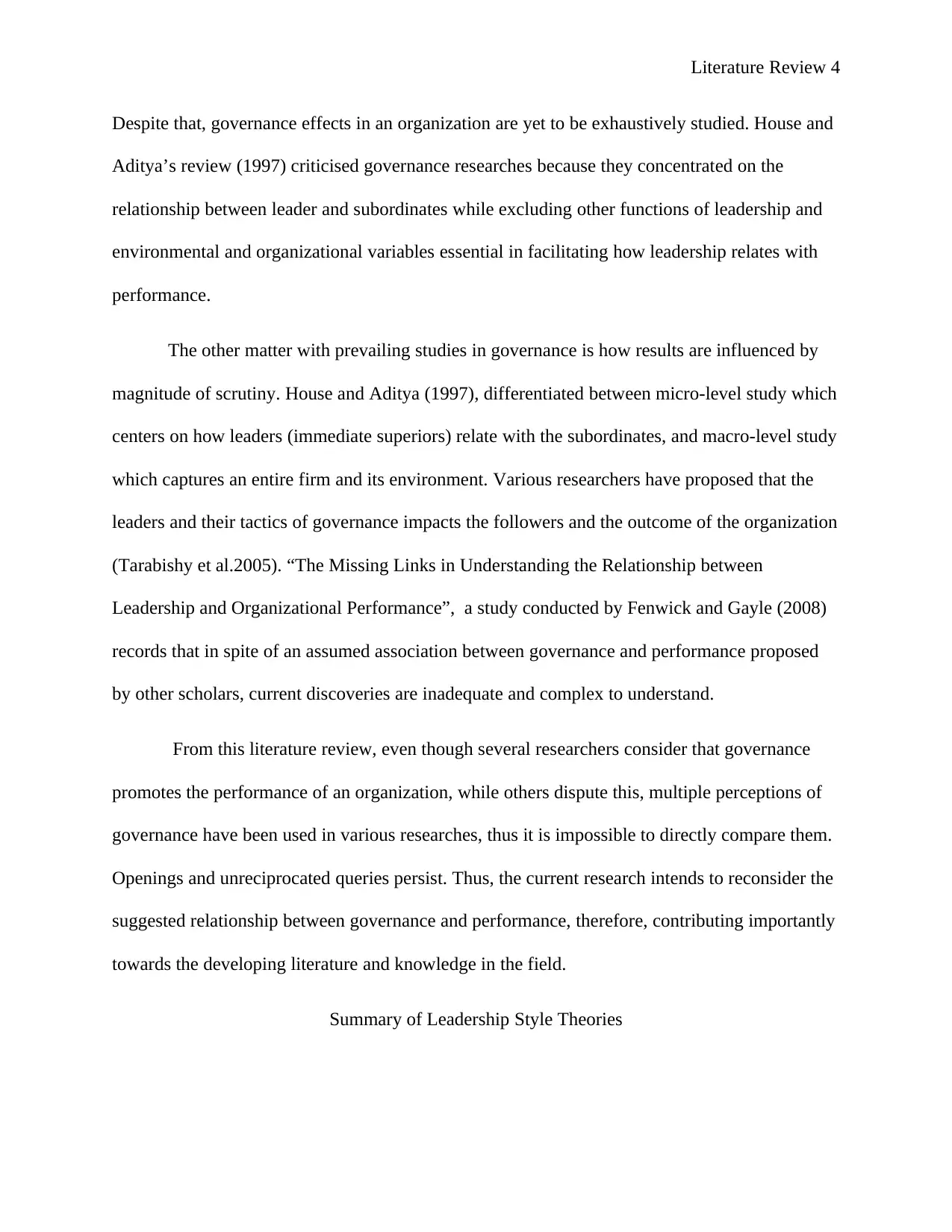Literature Review: Leadership Styles and Organizational Performance
VerifiedAdded on 2023/06/04
|5
|1243
|418
Literature Review
AI Summary
This literature review examines the multifaceted relationship between leadership and business performance, drawing upon various leadership theories and research findings. It begins by defining leadership as a critical component of organizational behavior, emphasizing its role in motivating employees and achieving organizational goals. The review explores different leadership styles, including transactional, transformational, and visionary leadership, and their impact on organizational outcomes such as profitability, market share, and product quality. It also addresses the historical evolution of leadership studies, from the Great Man theory to contemporary approaches, and highlights the ongoing debate regarding the effectiveness of different leadership styles in diverse organizational contexts. The review identifies gaps in existing research, particularly the need for more comprehensive studies that consider both micro- and macro-level factors, and concludes by emphasizing the importance of reconsidering the relationship between leadership and performance to contribute to the developing literature in the field. Desklib provides access to this and other solved assignments.

Literature Review 1
THE RELATIONSHIP BETWEEN LEADERSHIP AND BUSINESS PERFORMANCE
By
Course Name
Tutor/ Professor
University Affiliation
Date
THE RELATIONSHIP BETWEEN LEADERSHIP AND BUSINESS PERFORMANCE
By
Course Name
Tutor/ Professor
University Affiliation
Date
Paraphrase This Document
Need a fresh take? Get an instant paraphrase of this document with our AI Paraphraser

Literature Review 2
Literature Review on Leadership and Performance
Leadership is an essential component of organizational behavior. It is also one of the
most changing effect during interactions in the organization and at the individual level.
Therefore, the ability of management to embrace collaboration in the execution of tasks is highly
dependent on leader’s capabilities. A good leader is the one who motivates the abilities of the
followers and provides them with resources needed to achieve the organizational goals. Stogdill
(1957) records that leadership is a personal trait to govern followers to achieve a common goal.
According to Fry (2003), leadership incorporates the application of top strategies to
lender motivation and to improve the staff’s ability for development and growth. Multiple
justifications record that leadership style links to organizational performs. One of them is that
today’s rigorous and changing market features innovation-driven competition, pricing rivalry,
reduced returns, and outsmarting of the existing knowledge (Santora et al. 1999; Venkataraman
1997). Various researches argue that despite the presence of the above defies, reliable leadership
can enhance the performance of an organization (McGrath and MacMillan 2000; Teece, Pisano
and Shuen 1997).
Organization’s ability to realize its objectives such as increased profits, wide market
share, quality products, financial stability, and survival by adopting appropriate strategies defines
its performance (Koontz and Donnell 1993). Also, organization performance can be viewed in
the aspect of how an organization is performing in relation to profitability, market position, and
quality of the products when compared to competitors. Therefore, it portrays how productive
enterprise members are in relation to growth and development of the organization.
Literature Review on Leadership and Performance
Leadership is an essential component of organizational behavior. It is also one of the
most changing effect during interactions in the organization and at the individual level.
Therefore, the ability of management to embrace collaboration in the execution of tasks is highly
dependent on leader’s capabilities. A good leader is the one who motivates the abilities of the
followers and provides them with resources needed to achieve the organizational goals. Stogdill
(1957) records that leadership is a personal trait to govern followers to achieve a common goal.
According to Fry (2003), leadership incorporates the application of top strategies to
lender motivation and to improve the staff’s ability for development and growth. Multiple
justifications record that leadership style links to organizational performs. One of them is that
today’s rigorous and changing market features innovation-driven competition, pricing rivalry,
reduced returns, and outsmarting of the existing knowledge (Santora et al. 1999; Venkataraman
1997). Various researches argue that despite the presence of the above defies, reliable leadership
can enhance the performance of an organization (McGrath and MacMillan 2000; Teece, Pisano
and Shuen 1997).
Organization’s ability to realize its objectives such as increased profits, wide market
share, quality products, financial stability, and survival by adopting appropriate strategies defines
its performance (Koontz and Donnell 1993). Also, organization performance can be viewed in
the aspect of how an organization is performing in relation to profitability, market position, and
quality of the products when compared to competitors. Therefore, it portrays how productive
enterprise members are in relation to growth and development of the organization.

Literature Review 3
Efficient and reliable leadership is viewed as a strong input for gaining a competitive
advantage and for developing the management with an aim of improving the performance of the
firm (Avolio 1999; Lado, Boyd and Wright 1992; Rowe 2001). Transactional leadership links
reward with performance and provides the workers with all the required necessities to execute
the task (Zhu, Chew and Spengler 2005). Leaders who are governed by a vision, develop a
desired future state, use metaphors to share the vision, act consistently in order to model the
vision, and are committed towards achieving it (Avolio 1999; McShane and Von Glinow 2000).
Zhu et al. (2005), presents the idea of cohesion, motivation, commitment, and trust as major
result of visionary leadership thus consequently leading to good organizational performance
despite the new environment. Mehra, Smith, Dixon, and Robertson (2006) records that for firms
which are seeking an effective way to outsmart their competitors, the focus is mainly on
leadership and its effects.
Team leaders play a critical role in molding collective behavior and assisting their
groups to cope with environment and guiding collaborative action. The leader-focused approach
provides treasurable ideas into how performance relates with leadership (Guzzo and Dickson
1996). Various researches have scrutinized the leadership function, to capture the applicability
of leadership behaviour and paradigms in improving organization’s performance (Judge, Bono,
Ilies, and Gerhardt 2002; Judge and Piccolo 2004; Keller 2006; McGrath and MacMillan 2000;
Meyer and Heppard 2000; Purcell, Kinnie, Hutchinson and Dickson 2004; Yukl 2002).
According to Purcell et al. (2004), competencies, culture, style of leadership, and motivation are
key factors in achieving organizational performance by combining people and processes.
Preceding studies pioneered the anticipation that governance models will have a
unswerving effect on the contentment of customers, workers, and monetary performance.
Efficient and reliable leadership is viewed as a strong input for gaining a competitive
advantage and for developing the management with an aim of improving the performance of the
firm (Avolio 1999; Lado, Boyd and Wright 1992; Rowe 2001). Transactional leadership links
reward with performance and provides the workers with all the required necessities to execute
the task (Zhu, Chew and Spengler 2005). Leaders who are governed by a vision, develop a
desired future state, use metaphors to share the vision, act consistently in order to model the
vision, and are committed towards achieving it (Avolio 1999; McShane and Von Glinow 2000).
Zhu et al. (2005), presents the idea of cohesion, motivation, commitment, and trust as major
result of visionary leadership thus consequently leading to good organizational performance
despite the new environment. Mehra, Smith, Dixon, and Robertson (2006) records that for firms
which are seeking an effective way to outsmart their competitors, the focus is mainly on
leadership and its effects.
Team leaders play a critical role in molding collective behavior and assisting their
groups to cope with environment and guiding collaborative action. The leader-focused approach
provides treasurable ideas into how performance relates with leadership (Guzzo and Dickson
1996). Various researches have scrutinized the leadership function, to capture the applicability
of leadership behaviour and paradigms in improving organization’s performance (Judge, Bono,
Ilies, and Gerhardt 2002; Judge and Piccolo 2004; Keller 2006; McGrath and MacMillan 2000;
Meyer and Heppard 2000; Purcell, Kinnie, Hutchinson and Dickson 2004; Yukl 2002).
According to Purcell et al. (2004), competencies, culture, style of leadership, and motivation are
key factors in achieving organizational performance by combining people and processes.
Preceding studies pioneered the anticipation that governance models will have a
unswerving effect on the contentment of customers, workers, and monetary performance.
⊘ This is a preview!⊘
Do you want full access?
Subscribe today to unlock all pages.

Trusted by 1+ million students worldwide

Literature Review 4
Despite that, governance effects in an organization are yet to be exhaustively studied. House and
Aditya’s review (1997) criticised governance researches because they concentrated on the
relationship between leader and subordinates while excluding other functions of leadership and
environmental and organizational variables essential in facilitating how leadership relates with
performance.
The other matter with prevailing studies in governance is how results are influenced by
magnitude of scrutiny. House and Aditya (1997), differentiated between micro-level study which
centers on how leaders (immediate superiors) relate with the subordinates, and macro-level study
which captures an entire firm and its environment. Various researchers have proposed that the
leaders and their tactics of governance impacts the followers and the outcome of the organization
(Tarabishy et al.2005). “The Missing Links in Understanding the Relationship between
Leadership and Organizational Performance”, a study conducted by Fenwick and Gayle (2008)
records that in spite of an assumed association between governance and performance proposed
by other scholars, current discoveries are inadequate and complex to understand.
From this literature review, even though several researchers consider that governance
promotes the performance of an organization, while others dispute this, multiple perceptions of
governance have been used in various researches, thus it is impossible to directly compare them.
Openings and unreciprocated queries persist. Thus, the current research intends to reconsider the
suggested relationship between governance and performance, therefore, contributing importantly
towards the developing literature and knowledge in the field.
Summary of Leadership Style Theories
Despite that, governance effects in an organization are yet to be exhaustively studied. House and
Aditya’s review (1997) criticised governance researches because they concentrated on the
relationship between leader and subordinates while excluding other functions of leadership and
environmental and organizational variables essential in facilitating how leadership relates with
performance.
The other matter with prevailing studies in governance is how results are influenced by
magnitude of scrutiny. House and Aditya (1997), differentiated between micro-level study which
centers on how leaders (immediate superiors) relate with the subordinates, and macro-level study
which captures an entire firm and its environment. Various researchers have proposed that the
leaders and their tactics of governance impacts the followers and the outcome of the organization
(Tarabishy et al.2005). “The Missing Links in Understanding the Relationship between
Leadership and Organizational Performance”, a study conducted by Fenwick and Gayle (2008)
records that in spite of an assumed association between governance and performance proposed
by other scholars, current discoveries are inadequate and complex to understand.
From this literature review, even though several researchers consider that governance
promotes the performance of an organization, while others dispute this, multiple perceptions of
governance have been used in various researches, thus it is impossible to directly compare them.
Openings and unreciprocated queries persist. Thus, the current research intends to reconsider the
suggested relationship between governance and performance, therefore, contributing importantly
towards the developing literature and knowledge in the field.
Summary of Leadership Style Theories
Paraphrase This Document
Need a fresh take? Get an instant paraphrase of this document with our AI Paraphraser

Literature Review 5
Leadership has been a subject of interest since the 18th century. However scientific study
of leadership can be said to have commenced on the 20th century. Previous leadership studies
tried to understand governance from a theoretical line or perspective. The Great man theory
argues that leaders possess conspicuous traits which are present among ordinary people. The
Trait theory which was perceived as the leading leadership theory during the early 20th century
pursued to define the traits of strong leaders which encompasses psychological, physical, and
personal traits.
Inability to enumerate the effectiveness of leadership lead to the abandonment of
theoretical approach in the 1950s. Consequently, behavioral theory captured by the researches of
University of Michigan and Ohio State University had already occurred. The behavioral school
of thought focused mainly on identifying the behaviors that leaders possess and their effects on
the subordinates. In the 1960s researchers in the field of leadership focused more on situational
factors and how they affect the effectiveness of leadership.
Contingency or situational theories presented the lack of common traits of leadership that
are applicable in all situations. Transformational, transactional, and laissez-faire styles are the
full range of leadership and the recent developments in the area. This approach combined
insights from trait, 46 behavioral, and situational theories and developed on them.
Transformational leaders motivate subordinates to put group’s interest over individual priorities
and to achieve beyond the expectations, while transactional leaders emphasize on the clarity of
deliverables of a task and applicable rewards.
Leadership has been a subject of interest since the 18th century. However scientific study
of leadership can be said to have commenced on the 20th century. Previous leadership studies
tried to understand governance from a theoretical line or perspective. The Great man theory
argues that leaders possess conspicuous traits which are present among ordinary people. The
Trait theory which was perceived as the leading leadership theory during the early 20th century
pursued to define the traits of strong leaders which encompasses psychological, physical, and
personal traits.
Inability to enumerate the effectiveness of leadership lead to the abandonment of
theoretical approach in the 1950s. Consequently, behavioral theory captured by the researches of
University of Michigan and Ohio State University had already occurred. The behavioral school
of thought focused mainly on identifying the behaviors that leaders possess and their effects on
the subordinates. In the 1960s researchers in the field of leadership focused more on situational
factors and how they affect the effectiveness of leadership.
Contingency or situational theories presented the lack of common traits of leadership that
are applicable in all situations. Transformational, transactional, and laissez-faire styles are the
full range of leadership and the recent developments in the area. This approach combined
insights from trait, 46 behavioral, and situational theories and developed on them.
Transformational leaders motivate subordinates to put group’s interest over individual priorities
and to achieve beyond the expectations, while transactional leaders emphasize on the clarity of
deliverables of a task and applicable rewards.
1 out of 5
Related Documents
Your All-in-One AI-Powered Toolkit for Academic Success.
+13062052269
info@desklib.com
Available 24*7 on WhatsApp / Email
![[object Object]](/_next/static/media/star-bottom.7253800d.svg)
Unlock your academic potential
Copyright © 2020–2025 A2Z Services. All Rights Reserved. Developed and managed by ZUCOL.





